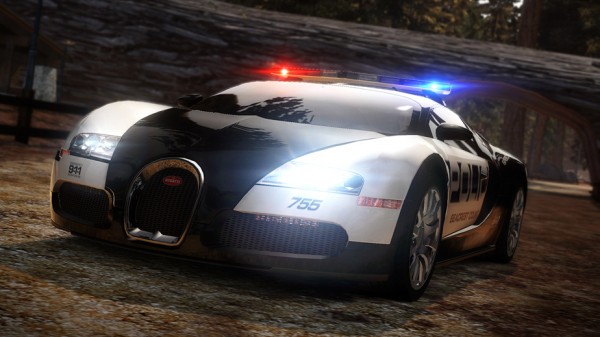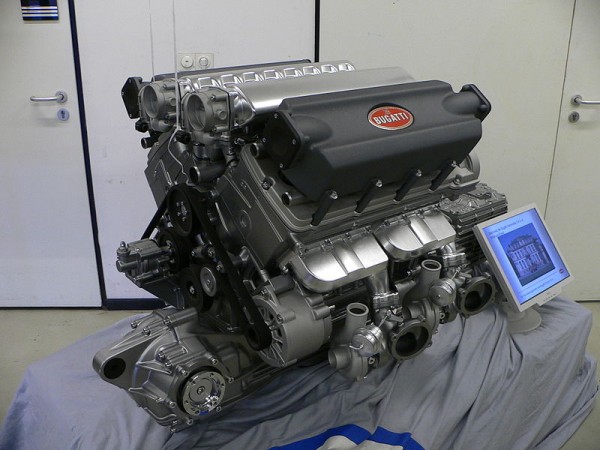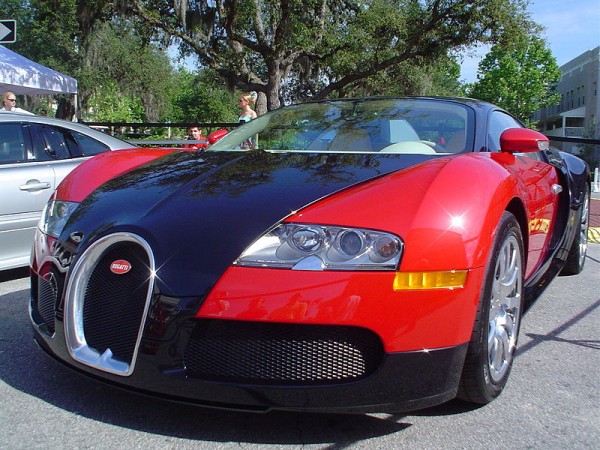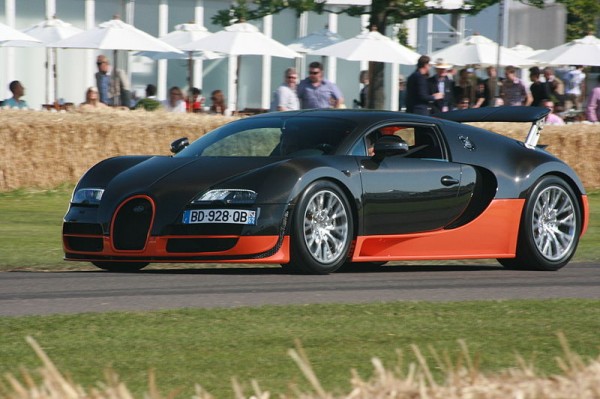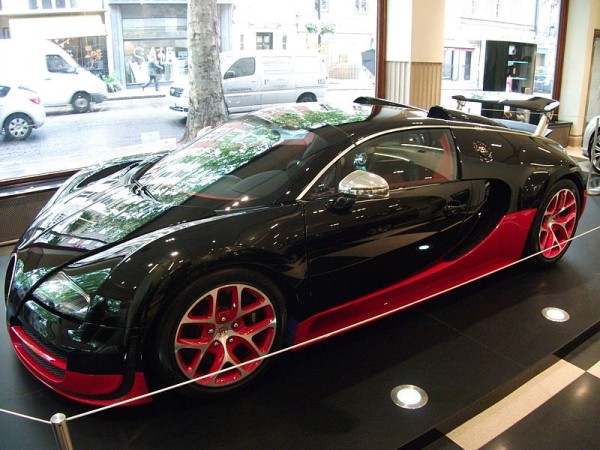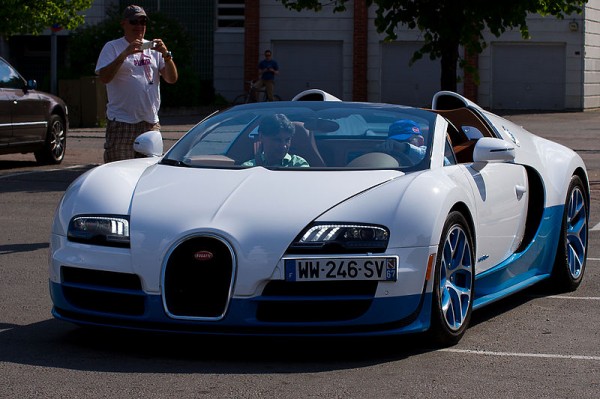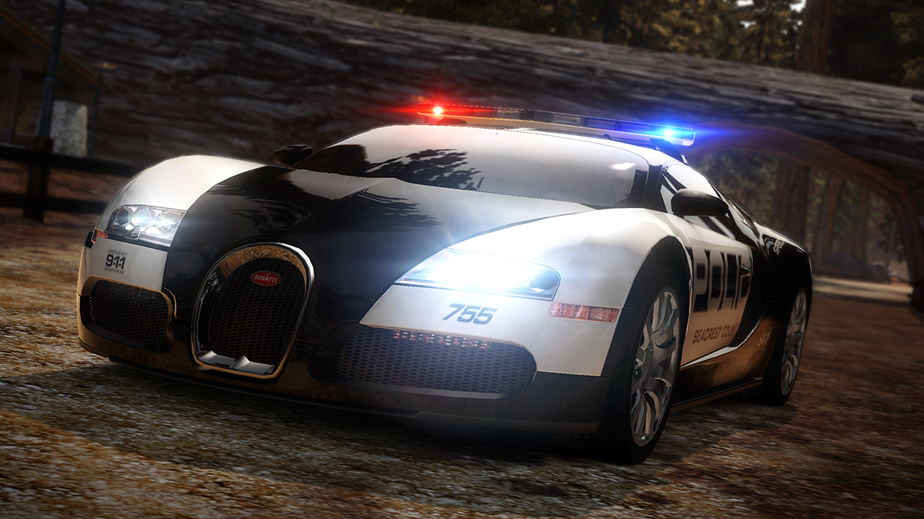
The Bugatti Veyron EB 16.4
The Bugatti Veyron EB 16.4
The Bugatti Veyron EB 16.4 is a mid-engined sports car, designed and developed by the Volkswagen Group and manufactured in Molsheim, France by Bugatti Automobiles S.A.S.
The Super Sport version of the Veyron is the fastest street-legal production car in the world, with a top speed of 431.072 km/h (267.856 mph).The original version has a top speed of 408.47 km/h (253.81 mph). It was named Car of the Decade (2000–2009) by the BBC television programme Top Gear. The standard Bugatti Veyron won Top Gear’s Best Car Driven All Year award in 2005.
On 6 April 2013, Bugatti set the record for having the highest top speed of any roadster in the world with the Veyron Grand Sport Vitesse, reaching on average a top speed of 408.84 km/h (254.04 mph).
The Veyron’s chief designer was Hartmut Warkuss, and the exterior was designed by Jozef Kabaň of Volkswagen, with much of the engineering work being conducted under the guidance of engineering chief Wolfgang Schreiber.
A number of special variants have been produced. In December 2010, Bugatti began offering prospective buyers the ability to customize exterior and interiors colours by using the Veyron 16.4 Configurator application on the marque’s official website.
Origin of the car
In 1998, the Volkswagen Group purchased the trademark rights on the former car manufacturer Bugatti in order to revive the brand. Starting with the Bugatti EB118, they presented at various international auto shows a total of four 18-cylinder concept cars. At the 1999 Tokyo Motor Show, the first study of the Veyron was presented. At the time, the name of the concept car was “Bugatti Veyron EB 18.4,” and it was equipped with a 3-bank W 18-cylinder engine instead of the 2-bank W 16-cylinder engine of the production version. While the three previous prototypes had been styled by Giugiaro, the Veyron was designed by the Volkswagen stylists.
The decision to start production of the car was taken by the Volkswagen Group in 2001. The first roadworthy prototype was completed in August 2003. It is identical except for a few details to the later series variant. In the development to series production, however, considerable technical problems had to be addressed, so that the start of production was delayed repeatedly, until September 2005.
Name origin
The Veyron EB 16.4 is named in honour of Pierre Veyron, a Bugatti development engineer, test driver and company race driver who, with co-driver Jean-Pierre Wimille, won the 1939 24 hours of Le Mans while driving a Bugatti. The “EB” refers to Bugatti founder Ettore Bugatti and the “16.4” refers to the engine’s 16 cylinders and four turbochargers.
World record controversy
At the beginning of April 2013, driving.co.uk (also known as Sunday Times Driving) began an investigation following claims from US car maker Hennessey that its 928 kW (1,244 bhp) Hennessey Venom GT was the new world’s fastest production car, taking the crown from the Guinness World Record-holding Bugatti Veyron Super Sport. With a recorded speed of 427.6 km/h (265.7 mph) the Hennessey was 3.4 km/h (2.1 mph) slower than the Veyron but Hennessey dismissed Bugatti’s official record saying that the Veyron Super Sport was restricted to 415 km/h (258 mph) in production form and that for it to achieve its record top speed of 431.0 km/h (267.8 mph), the car used was in a state of tune not available to customers. Hennessey said its Venom GT, on the other hand, was road-ready and unmodified and was therefore a production car in the strict sense of the term.
Driving.co.uk requested clarification from Guinness World Records, which investigated this claim and found that indeed the modification was against the official guidelines of the record. Upon finding this, Guinness World Records voided the Super Sport’s record and announced it was “reviewing this category with expert external consultants to ensure our records fairly reflect achievements in this field.”
After further review, SSC, the producers of the Ultimate Aero TT, said that they had reclaimed the record. However Guinness World Records later said they had reinstated the Super Sport’s record, after coming to the conclusion that “a change to the speed limiter does not alter the fundamental design of the car or its engine.
Bugatti Veyron (2005–2011)
The Veyron’s quad-turbocharged W16 engine
Specifications and performance
The Veyron features an 8.0-litre, quad-turbocharged, W16 cylinder engine, equivalent to two narrow-angle V8 engines. Each cylinder has four valves for a total of 64, but the VR8 configuration of each bank allows two overhead camshafts to drive two banks of cylinders so only four camshafts are needed. The engine is fed by four turbochargers and displaces 7,993 cubic centimetres (487.8 cu in), with a square 86 by 86 mm (3.39 by 3.39 in) bore and stroke.
First U.S. Bugatti Veyron on display in April 2006
The transmission is a dual-clutch direct-shift gearbox computer-controlled automatic with seven gear ratios, with magnesium paddles behind the steering wheel and a shift time of less than 150 milliseconds, built by Ricardo of England rather than Borg-Warner, who designed the six speed DSG used in the mainstream Volkswagen Group marques. The Veyron can be driven in either semi-automatic or fully automatic mode. A replacement transmission for the Veyron costs just over US$120,000.[19] It also has permanent all-wheel drive using the Haldex Traction system. It uses special Michelin PAX run-flat tyres, designed specifically to accommodate the Veyron’s top speed, and cost US$25,000 per set.[19] The tyres can be mounted on the rims only in France, a service which costs US$70,000. Kerb weight is 1,888 kilograms (4,162 lb).[20] This gives the car a power-to-weight ratio, according to Volkswagen Group’s figures, of 530 PS (390 kW; 523 bhp) per ton.
The car’s wheelbase is 2,710 mm (106.7 in). Overall length is 4,462 mm (175.7 in) which gives 1,752.6 mm (69.0 in) of overhang. The width is 1,998 mm (78.7 in) and height 1,204 mm (47.4 in). The Bugatti Veyron has a total of ten radiators:
3 heat exchangers for the air-to-liquid intercoolers.
3 engine radiators.
1 for the air conditioning system.
1 transmission oil radiator.
1 differential oil radiator.
1 engine oil radiator
It has a drag coefficient of 0.41 (normal condition) and 0.36 (after lowering to the ground),[22] and a frontal area of 2.07 m2 (22.3 sq ft).[23] This gives it a drag area – the combination of drag coefficient and frontal area, represented as CdA – of 0.74 m2 (8.0 sq ft).
Engine output
According to Volkswagen Group and certified by TÜV Süddeutschland, the final production Veyron engine produces 1,001 metric horsepower (736 kW; 987 bhp) of motive power, and generates 1,250 newton metres (922 lbf·ft) of torque.The nominal figure has been stated by Bugatti officials to be conservative, with the real total being 1,020 metric horsepower (750 kW; 1,006 bhp).
Top speed
German inspection officials recorded an average top speed of the original version of 408.47 km/h (253.81 mph) during test sessions on the Ehra-Lessien test track on 19 April 2005.
This top speed was verified by James May on Top Gear in November 2006, again at Volkswagen Group’s private Ehra-Lessien test track. May noted that at top speed the engine consumes 45,000 litres (9,900 imp gal) of air per minute (as much as a human breathes in four days). The Veyron at the time had the highest top speed of any street legal production car. Back in the Top Gear studio, co-presenter Jeremy Clarkson commented that most supercars felt like they were shaking apart at their top speed, and asked May if that was the case with the Veyron at 407 km/h (253 mph). May responded that no, the Veyron was very controlled, and only wobbled a tiny bit when the air brake deployed.
The car’s everyday top speed is listed at 343 km/h (213 mph). When the car reaches 220 km/h (140 mph), hydraulics lower the car until it has a ground clearance of about 9 cm (3.5 in). At the same time, the wing and spoiler deploy. In this handling mode, the wing provides 3,425 newtons (770 lbf) of downforce, holding the car to the road.
For top speed mode the driver must, while stationary, toggle a special top speed key to the left of the driver’s seat. A checklist then establishes whether the car and its driver are ready to attempt to reach 407 km/h (253 mph). If so, the rear spoiler retracts, the front air diffusers shut, and normal 12.5 cm (4.9 in) ground clearance drops to 6.5 cm (2.6 in).
Braking
The Veyron’s brakes use cross drilled, radially vented carbon fibre reinforced silicon carbide (C/SiC) composite discs, manufactured by SGL Carbon, which have a much greater resistance to brake fade when compared with conventional cast iron discs. The lightweight aluminium alloy monobloc brake calipers are made by AP Racing; the fronts have eight[21] titanium pistons and the rear calipers have six pistons. Bugatti claims maximum deceleration of 1.3 g on road tyres. As an added safety feature, in the event of brake failure, an anti-lock braking system (ABS) has also been installed on the handbrake.
Prototypes have been subjected to repeated 1.0 g braking from 312 km/h (194 mph) to 80 km/h (50 mph) without fade. With the car’s acceleration from 80 km/h (50 mph) to 312 km/h (194 mph), that test can be performed every 22 seconds. At speeds above 200 km/h (120 mph), the rear wing also acts as an airbrake, snapping to a 55° angle in 0.4 seconds once brakes are applied, providing an additional 0.68 g (6.66 m/s2) of deceleration (equivalent to the stopping power of an ordinary hatchback).[21] Bugatti claims the Veyron will brake from 400 km/h (250 mph) to a standstill in less than 10 seconds, though distance covered in this time will be half a kilometre (third of a mile).
Special versions
Pur Sang (2007)
Launched on 11 September 2007 at the Frankfurt Motor Show the “Pur Sang”[32] (literally Pure Blood, but more accurately translated as Thoroughbred) is a limited run of five cars.[33] They have high-gloss bronze roadwheels with a diamond-cut glass-like finish and a clear body finish revealing the Veyron’s silver oxide finish carbon fibre body, but are otherwise standard.
Pegaso (2007)
This special edition Veyron was made for a rich Ukrainian living in Dubai. Some reports say that the Pegaso had its power increased from 1,001 PS (736 kW; 987 bhp) to 1,200 PS (880 kW; 1,200 bhp), making it as powerful as a Super Sport. The Pegaso name comes from a Spanish coachbuilder that used to build luxury cars, such as the Pegaso Z-102.[34]
Fbg Par Hermès (2008)
A Hermès-themed model: Hermès monogram on the front grille, roadwheels with a single H in the centre, and fuel filler door engraved with Bugatti Veyron Fbg Par Hermès. The interior is done in Hermès leather with internal door handles reminiscent of handles used on Hermès trunks – and a Hermès wallet and Hermès suitcase is included.
Sang Noir (2008)
A limited run of 15 cars with an all-black exterior colour palette and a bright orange interior. In 2012 Gemballa Racing unveiled their Sang Noir wrapped in Gemballa blue with glow-in-the-dark lightning flashes to be used as a promotional vehicle for Gemballa Racing.
Bleu Centenaire (2009)
A celebratory model unveiled at the 2009 Geneva Motor Show[39] for the 100th anniversary of the Bugatti brand. The entire body is painted in a combination of matte and gloss “Bugatti Blue”, the midsection between the two wings on the hood is expanded, and a chrome strip up the middle added.
L’Edition Centenaire (2009)
The Bugatti Centenaire Villa d’Este Limited Edition is an homage to the golden age of motorsport in the first half of the last century. As such, it is reminiscent of the historic Bugatti Type 35 thoroughbred racing car. Each of the four finishes available symbolises one of the great European racing nations of the 1920s. Only 4 cars were made and the four cars have different colours.
The drivers from which the L’Edition Centenaire was inspired are:
Jean-Pierre Wimille from France: two tone blue and silver colour
Achille Varzi from Italy: two tone Red and silver colour
Malcolm Campbell from UK: two tone Green and Silver colour
Prince Hermann Zu Leiningen from Germany: two tone Beige and silver colour
Sang d’Argent (2010)
First shown at the 2009 Dubai Motor Show, this one-off is finished in matte silver and polished aluminium. It was inspired by the two tone finish of the Centenary Villa d’Este cars and the previous Pur Sang edition. The car was sold for US$2.1 million.
Nocturne (2010)
Also at the 2009 Dubai Motor Show, the car was unique because of its galvanised side windows. This Veyron is distinguished by its polished aluminum line that starts at the front of the vehicle and finishes with the wide rear arches. The rest of the vehicle is coated in uniblack. Inside, it has a dark magnesium dashboard and a galvanized Platinum center console. Just five were produced, exclusively for the Middle East, for an even higher price of US$2.4 million.[43] As the standard Veyron 16.4 sold out in 2011, this was the last special edition for the “normal” Veyrons.
Bugatti Veyron Grand Sport (2009–)
A targa top version unveiled at Pebble Beach Concours d’Elegance[49] on 15 August 2008, with production beginning in the second quarter of 2009. The model has extensive reinforcements to compensate for the lack of standard roof,[50] and small changes to the windshield and running lights. There are two removable tops, the second a temporary roof fashioned after an umbrella. The top speed with the hardtop in place is the same as the standard coupé version, but with the roof down is limited to 369 km/h (229 mph)—and to 130 km/h (81 mph) with the temporary soft roof. The first (chassis 001) was sold at auction, raising approximately US$900,000 for charity.
Special versions
Sang Bleu (2010)
Blue carbon-fibre with polished aluminium, wheels inspired by the Grand Sport Roadster, highlighted in a Midnight Blue and Diamond Cut two-tone finish.
Soleil de Nuit (2010)
Exclusively for the Middle East, the Soleil de Nuit was unveiled at the 2009 Dubai Motor Show. It combines polished aluminium accents with metallic blue/black paint. It also features a burnt orange interior. It was sold for US$2.27 million.
Grey Carbon (2010)
The Grey Carbon was first shown to the public at the 2010 Geneva Motor Show. The exterior features exposed carbon-fibre with metallic dark grey aluminum body panels, and lower portion in polished aluminium. Only one Grand Sport Grey Carbon edition was made.
Royal Dark Blue (2010)
Like the Grey Carbon, the Royal Dark Blue was a show car at Geneva 2010. It features a carbonfibre monocoque and the bonnet and rear section finished in Royal Dark Blue, hence the name. The rest of the car is painted Arctic White. It sold for €1.75 million.
Sang Blanc (2010)
This car was designed at the request of a client from the UK. It is finished in a matte pearlescent white with black front grille, exhaust and engine cover, as well as a black interior.[55] In 2011, Derbyshire-based exotic car dealer Tom Hartley sold the Sang Blanc, with 448 miles on the odometer, for GB£1.25 million.[56] On 25 August 2012, the Sang Blanc was involved in a crash near to Mandelieu-la-Napoule, France. The front right fender and the right headlight sustained some damage.
Bijan Pakzad Edition (2011)
Bijan Pakzad Edition photographed outside the House of Bijan boutique in Beverly Hills, California.
Just before unexpectedly passing away due to a stroke, the Iranian born fashion designer Bijan Pakzad collaborated with Bugatti to design this one-off Veyron. The car features a unique yellow and black colour scheme. It also features a lot of decals, like the handwritten-look ‘Bijan’ logo on the underside of the rear wing. It is currently parked outside of the “House of Bijan” boutique on Rodeo Drive.
Matte White (2011)
First shown at the 2011 Shanghai Auto Show, the Matte White, as its name suggests, features a matte white paint finish, with the lower section of the car finished in blue carbon fibre. The interior is also blue. It was sold soon after it was put on display.
L’Or Blanc (2011)
Teaming up with Königliche Porzellan-Manufaktur, Bugatti created the one-off Veyron “L’Or Blanc”. Its name means “white gold”, and the special Grand Sport uses porcelain to distinguish its body and interior with a blue and white pattern.
Red Edition (2011)
Shown at the 2011 Frankfurt Motor Show, this special edition features the whole car (body and interior) painted red. Even the wheels were painted red. It is thought Bugatti brought this car to Frankfurt to speed up purchases of the Grand Sport, as the sales figure was disappointingly low.
Middle East Editions (2011)
Three different ‘Middle East Edition’ cars were unveiled at the 2011 Dubai Motor Show. The first car combines a bright yellow exterior and interior with black carbon fibre inserts and black wheels. The second has a blue carbon framed exterior with polished aluminium and an orange interior. The final edition features a green carbon finish, once again framed with polished aluminium. The yellow model sold for €1.58 million, while the other two were sold for €1.74 million.
Vitesse (2012)
Grand Sport Vitesse side view
The Vitesse is a version of the Grand Sport with a Super Sport engine. The vehicle was unveiled at the 2012 Geneva Motor Show.[66] It produces a maximum output of 1,200 PS (880 kW; 1,200 bhp) @ 6,400 rpm and a maximum torque of 1,500 N·m (1,100 lb·ft) @ 3,000-5,000 rpm. These figures allow the car to reach 100 km/h (62 mph) from standing in 2.6 seconds. On the 6th of April, 2013, the Vitesse set the record for the fastest roadster in the world with an average top speed of 408.84 km/h (254.04 mph). The maximum speed can only be reached on closed tracks. On normal roads, the Vitesse is electronically limited to 375 km/h (233 mph). It costs €2 million.
After the world record attempt, Dr. Wolfgang Schreiber, President of Bugatti Automobiles S.A.S, said “When we introduced the Vitesse, we established the top speed for open-top driving to be 375 km/h. Still, we could not let go of the idea of reaching the 400 km/h mark with this car as well. The fact that we have succeeded in reaching 408.84 km/h is a thrill for me, and it reaffirms once again that Bugatti is the leader when it comes to technology in the international automotive industry.” The driver, Anthony Liu, claimed “Even at such high speeds it remained incredibly comfortable and stable. With an open top, you can really experience the sound of the engine and yet even at higher speeds I did not get compromised by the wind at all.”
Vitesse SE (2012)
Bugatti Veyron Grand Sport Vitesse SE, photographed in Tampere, Finland June 2013
The Vitesse SE was first shown at Pebble Beach Concours d’Elegance in Monterey, California. It features a bespoke Bianco and New Light Blue colour scheme as a reminder of the 1928 Bugatti Type 37A.
Vitesse WRC (2013)
The Vitesse WRC (World Record Car) is coloured black and features orange vinyls around the headlights and grille, as well as having orange rims and interior. Eight will be made for a price of €1.99 million.
Wei Long (2012)
First shown at the 2012 Beijing Auto Show, the Wei Long was built by Bugatti to commemorate the Chinese year of the Dragon. It was developed alongside Königliche Porzellan-Manufaktur, the same firm responsible for the Veyron L’Or Blanc, who fitted several high-quality porcelain motifs. Most of the pieces depict a dragon and are featured on the body and in the cabin, endowing the car with deep Chinese cultural heritage. Some locations include on the surface of the oil and fuel filler cap. Other details include a pearl white exterior with contrasting carmine red interior, headrests embroidered with the Chinese “Dragon” character, and hand-crafted pure silk floor mats embossed with more dragon logos. It was sold for €1.58 million.[70]
Bernar Venet (2012)
In 2012, Bugatti invited Bernar Venet to create a one-off artwork to be applied to a Veyron Grand Sport. The finished work, described as “the fastest artwork ever”, features an interpretation of Venet’s trademark mathematical equations and was revealed at the Rubell Family Collection in Miami during Art Basel Miami Beach.[71]
Bugatti Veyron Super Sport (2010–)
A Bugatti Veyron 16.4 Super Sport World Record Edition – the fastest road legal production car reaching 431 km/h
The Veyron Super Sport features an engine power increase from the standard 1,001 PS (736 kW; 987 bhp) to 1,200 PS (880 kW; 1,200 bhp) and torque of 1,500 N·m (1,100 lbf·ft) and a revised aerodynamic package.[72] It has a 431.072 km/h (267.856 mph) top speed, making it the fastest production road car in production [3][73][74] although it is electronically limited to 415 km/h (258 mph) to protect the tyres from disintegrating.[72] It was shown publicly for the first time at the Pebble Beach Concours d’Elegance in August 2010.[1] The first five Super Sport models were exclusively finished in a bicolor horizontal split of black visible carbon fibre and orange and each was titled as World Record Edition (WRE). The Super Sport is valued at GB£1.7 million and Bugatti have stated that only 30 will be produced.
On 4 July 2010 James May, a television presenter on BBC 2’s television show Top Gear, drove the Veyron Super Sport at 417 km/h (259 mph). Later that day, Bugatti’s official test driver Pierre Henri Raphanel drove the Super Sport version of the Veyron on Volkswagen’s Ehra-Lessien (near Wolfsburg, Germany) high-speed test track to establish the car’s top speed. With representatives of the Guinness Book of Records and German Technical Inspection Agency (TÜV) on hand, Raphanel made passes around the big oval in both directions achieving an average maximum speed of 431.072 km/h (267.856 mph), thus taking back the title from the SSC Ultimate Aero TT as the fastest production vehicle of all time.[4] The 431.072 km/h mark was reached by averaging the Super Sport’s two test runs, the first reaching 427.93 km/h (265.90 mph) and the second 434.20 km/h (269.80 mph). Once produced for sale, the first five Super Sports will sport the same black and orange finish as the first production car which was used to set the speed record.
The car then went round the Top Gear Test Track and topped the lap leader board with a 1:16.8 time, beating the 1:17.1 record set previously by the Gumpert Apollo Sport.
On 9 April 2013 the Title of “Fastest Production Car in the World” was revoked due to the deactivation of the electronic speed limiter which makes the car non stock, going against the rules of the title.[76] Later, Bugatti’s speed record has been restored. “Following a thorough review conducted with a number of external experts, Guinness World Records is pleased to announce the confirmation of Bugatti’s record of Fastest production car achieved by the Veyron 16.4 Super Sport. The focus of the review was with respect to what may constitute a modification to a car’s standard specification. Having evaluated all the necessary information, Guinness World Records is now satisfied that a change to the speed limiter does not alter the fundamental design of the car or its engine.”
Special versions
Sang Noir (2011)
Introduced for customers who did not like the look of the ‘World Record Edition’, the Sang Noir was a show car at the 2011 Geneva Motor Show. The car is finished entirely in black, except for the interior, which is bright tangerine orange. The car costs a very high US$3.4 million, US$1 million more than a standard Super Sport.
Black Carbon (2011)
First shown at the 2011 Shanghai Auto Show, the Black Carbon was built for a customer in China. This car is finished in a black clear-coat, revealing the carbon fibre body. The black exterior is combined with “Snow Beige” and “Beluga Black.”
Edition Merveilleux (2011)
Unveiled in December 2011, the Edition Merveilleux was presented by Bugatti to a car collector from China known only as “Simon”, commemorating the 40th birthday of the buyer. In a video released by Bugatti, featuring a number of Bugatti’s top execs including CEO Wolfgang Dürheimer, they wish Simon a happy 40th birthday. The Edition Merveilleux features an un-painted carbon fibre exterior with matching blacked-out alloy wheels and a bright blue interior. It is the first Super Sport in the Chinese market.
Le Saphir Bleu (2012)
In early September 2012, a Super Sport with the same exterior design as the L’or Blanc was seen driving around Molsheim. It is believed to be called “Le Saphir Bleu” (The Blue Sapphire).
Pur Blanc (2012)
In late September 2012, a Pur Blanc Super Sport was built for a customer in the United States. The Pur Blanc edition takes its name from the French for “pure white” but actually has a fair bit of black thrown in for good measure.
Future development
In 2008, Bugatti then-CEO Dr Franz-Josef Paefgen confirmed that the Veyron would be replaced by another high-end model by 2012.[85] In 2011, the new CEO Wolfgang Dürheimer revealed that the company was planning to produce two models in the future — one a sports car-successor to the Veyron, the other a limousine known as the Galibier.
Bugatti SuperVeyron
In 2011, Wolfgang Dürheimer stated that the company was committed to producing the world’s fastest car, and would respond to any competitors that produced a faster car.[87] In October 2012, Automobile Magazine reported rumours of a new variant called the SuperVeyron which was due to debut at the Frankfurt Motor Show in September 2013. However, Bugatti president Dr. Wolfgang Schreiber spoke with Autoblog and announced that no such project is in development. Despite this he did state that a replacement for the Veyron model is in the works after the model reaches its end of production.
16C Galibier
Main article: Bugatti 16C Galibier
The Bugatti 16C Galibier concept is a prototype of a luxury sedan which was presented officially in September 2009 by Bugatti prior to the IAA 2009. A derivative of the concept vehicle is expected to reach the market in 2015. The car is a 4-door luxury sedan which shares the W16 8.0L engine of the Veyron, but with two superchargers instead of four turbochargers for improved torque.It would be produced in larger volumes than the Veyron and may incorporate a hybrid option.
In September 2013 Bugatti announced that it will be dropping the Galibier Project to focus solely on the successor to the Veyron.
| Overview | |
|---|---|
| Manufacturer | Bugatti Automobiles S.A.S. |
| Production |
|
| Assembly | Molsheim, Alsace, France |
| Designer | Jozef Kaban |
| Body and chassis | |
| Class | Sports car |
| Body style | |
| Layout | Longitudinal mid-engine, permanent all wheel drive |
| Powertrain | |
| Engine | Standard (Coupe), Grand Sport (Roadster): 8.0 L (488 cu in) W16 quad-turbocharged 1,001 PS (736 kW; 987 bhp) Super Sport (Coupe), Grand Sport Vitesse (Roadster): 1,200 PS (883 kW; 1,184 bhp) |
| Transmission | 7-speed DSG sequential |
| Dimensions | |
| Wheelbase | 2,710 mm (106.7 in) |
| Length | 4,462 mm (175.7 in) |
| Width | 1,998 mm (78.7 in) |
| Height | 1,159 mm (45.6 in) |
| Kerb weight | 1,888 kg (4,162 lb) |
| Chronology | |
| Predecessor | Bugatti EB110 |
A Bugatti Veyron 16.4 Super Sport World Record Edition – the fastest road legal production car reaching 431 km/h
Grand Sport Vitesse side view
Bugatti Veyron Grand Sport Vitesse SE, photographed in Tampere, Finland June 2013
Source: Wikipedia

